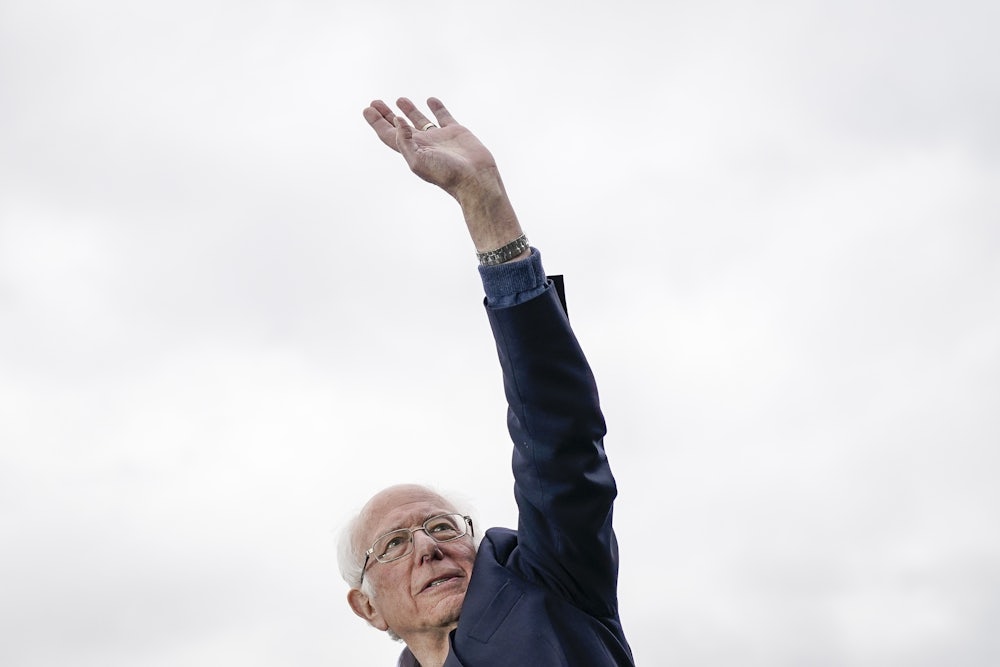There’s little love for Bernie Sanders on the television news circuit. After his landslide win in Saturday’s Nevada caucuses, MSNBC host Chris Matthews compared the victory to Nazi Germany’s successful invasion of France in 1940. Also on MSNBC, James Carville, who ran Bill Clinton’s 1992 campaign, deemed it a big win for Vladimir Putin. On CBS, former Obama chief of staff Rahm Emmanuel fretted that Democrats were making a suicidal choice in going for Sanders. Donna Brazile, the former Democratic National Committee chair turned Fox News contributor, and Joe Lockhart, the former Clinton administration press secretary and current CNN contributor, were irked by a Sanders tweet that read: “I’ve got news for the Republican establishment. I’ve got news for the Democratic establishment. They can’t stop us.”
If you have watched television over the past several weeks, you will have seen something resembling the seven stages of grief unfold. There has been shock and denial, anger and bargaining, as pundits have attempted to come to grips with Sanders’s rise. And, finally, we have seen acceptance, even though Sanders and his campaign continue to thumb their noses at television news—particularly cable news.
This was a risky decision, but it was necessitated by the coverage that the campaign was receiving on cable television. Sanders’s campaign manager, Faiz Shakir, acknowledged that unflattering coverage on MSNBC, the supposed liberal network, had “actively damaged” the campaign. “The constant diminishment of Bernie Sanders on MSNBC hurts his case for electability,” he said, particularly with its audience of older loyal Democratic voters.
And yet, heading into Super Tuesday, there are signs that the Sanders campaign’s strategy is paying off. Not only is Sanders the clear front-runner, but cable news coverage is shifting. Matthews apologized for his remarks on Monday, amid calls for his firing. Networks are hiring more pro-Sanders pundits to appear on their roundtables. And, bowing to its critics, MSNBC is reportedly reconsidering its entire approach to 2020 coverage.
The Sanders campaign has accomplished this not only by placing concerted pressure on news outlets but also by bypassing traditional outlets and building its own media infrastructure.
Working the refs is nothing new. Shakir and Sanders himself have done some traditional influence work: Both sat down with MSNBC President Phil Griffin months ago to try to mend fences. These informal tête-à-têtes between network bigwigs and candidates are a standard feature of the election process but rarely result in dramatic changes: After the meeting, the network’s coverage of Sanders continued to oscillate between derision and dismissiveness.
The campaign has found more success in antagonism than in glad-handing and backroom deals. Establishments of all types are in Sanders’s crosshairs—his campaign thus far is a refutation of the conventional wisdom that multifront wars cannot be won—including the establishment of the “corporate media.” Running against “the corporate media” underscores Sanders’s underdog appeal and outsider status, and bolsters his us-against-the world campaign.
Sanders has also made a number of crucial hires and decisions to counter the dominant narratives on cable news. As Vanity Fair’s Tom Kludt noted, his “2020 campaign has doubled as a rolling media criticism shop.” At times, it resembles an alternative media outlet all its own. That’s no surprise given that so many of its staffers have roots in liberal and left-wing media. Shakir edited Think Progress; speechwriter David Sirota worked at In These Times and The Young Turks; press secretary Briahna Joy Gray came from Current Affairs; deputy campaign manager Ari Rabin-Havt worked at Media Matters.
The campaign is using new media—podcasts, newsletters, social media—to undercut traditional media. Gray’s podcast Hear the Bern pushes back on many of the claims you hear from cable news pundits—that Sanders’s base is too white and full of bros, for instance, or that he is unelectable. “Bern Notice,” a newsletter written by Sirota, resembles the left-wing fare on Substack, attacking the corporate media and disseminating pro-Sanders pieces. The campaign also has its own live-streamed television show, The 99. “We are doing these livestreams, we are talking to you directly,” Shakir said last summer. “One of the reasons is, while we appreciate our friends in the elite media, they don’t often cover the issues that truly matter to working Americans.” “You can control your message,” Sirota told The New York Times last year. “But you have to let people fight the fight.”
These efforts have attracted a great deal of negative attention, partly because of their attacks on other Democrats and the media and partly because of their tone. Sirota and Gray, who are caustic on Twitter, have received considerable criticism, and Gray recently took heat for comparing questions about Sanders’s health records to birtherism. (She responded by defending the analogy.) But with few friends in cable news, the Sanders campaign felt it had to play its own game.
There have been comparisons between the Sanders campaign’s approach to media and Trump’s, both in terms of tone and substance. Both are aggressive, and both aim to reach people directly, without a filter. But Trump has a cable news channel in his pocket—Sanders does not. His campaign has responded by building a media infrastructure that could withstand attacks from mainstream networks. So far, it’s worked wonders.
